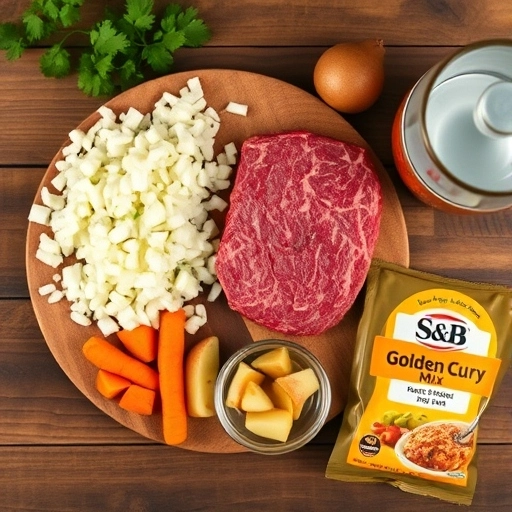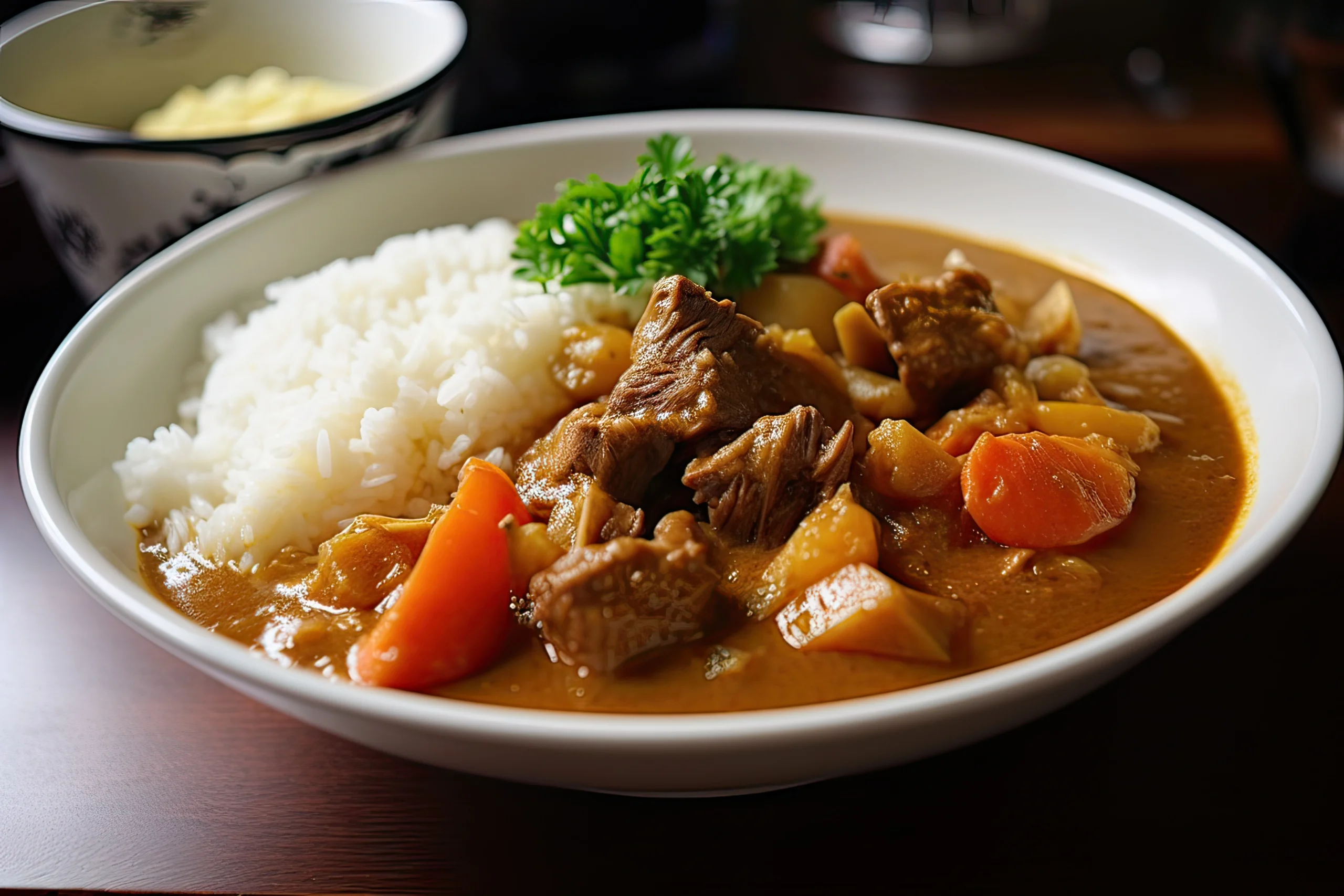Golden Curry is a rich and flavorful dish featuring tender beef (or chicken, lamb, or shrimp), hearty vegetables like potatoes and carrots, and a savory curry sauce. This dish is perfect for those looking for a comforting, spicy meal served with steamed rice. Follow this easy recipe to create a delicious Golden Curry!
Ingredients:
For the Curry:
- 450 g (1 lb) of chopped beef (or chicken, lamb, or shrimp)
- 1 3/4 medium onions (350 g / 13 oz), finely minced
- 1/2 medium carrot (100 g / 3.5 oz), chopped into small pieces
- 1 medium potato (150 g / 5 oz), diced
- 1 tablespoon vegetable oil
- 540 ml water
- 1 package (92 g) of S&B Golden Curry Sauce Mix
For the Rice:
- 2 cups jasmine rice (or any long-grain rice)
- 4 cups water
- 1/2 teaspoon salt (optional)

Instructions:
Step 1: Prepare the Ingredients
- Chop the beef (or chicken, lamb, or shrimp) into bite-sized pieces.
- Mince the onions and chop the carrots and potato into bite-sized pieces.
- Rinse the rice under cold water until the water runs clear.
Step 2: Cook the Meat
- Heat 1 tablespoon of vegetable oil in a large pot over medium heat.
- Add the chopped meat (beef, chicken, lamb, or shrimp) and cook until browned on all sides (about 5-7 minutes). Once browned, remove the meat and set it aside.
Step 3: Sauté the Onions and Vegetables
- In the same pot, add the minced onions and sauté for 3-4 minutes until softened.
- Add the chopped carrots and potatoes and sauté for another 2-3 minutes.
Step 4: Add Water and Curry Sauce Mix
- Pour in the 540 ml of water and bring the mixture to a simmer.
- Break the S&B Golden Curry Sauce Mix into chunks and add it to the pot. Stir well to dissolve the curry mix into the water.
Step 5: Simmer the Curry
- Return the cooked meat to the pot and stir everything together.
- Cover the pot and let it simmer over low heat for 20-30 minutes, or until the meat is tender and the vegetables are cooked through.
Step 6: Prepare the Rice
- While the curry is simmering, rinse the jasmine rice under cold water and then cook it according to the package instructions (typically, combine rice and 4 cups of water, bring it to a boil, then cover and simmer for 15-18 minutes until cooked).
Step 7: Serve
- Once the curry is ready, serve it hot over the steamed rice. You can garnish with fresh cilantro or a sprinkle of chili flakes for extra heat if desired.
Recipe Breakdown:
Time:
| Activity | Time |
|---|---|
| Prep Time | 15 mins |
| Cooking Time | 40 mins |
| Total Time | 55 mins |
Nutrition (Per Serving, Serves 4):
NutrientAmount per Serving
| Nutrient | Amount per Serving |
|---|---|
| Calories | 450 kcal |
| Protein | 25 g |
| Carbohydrates | 40 g |
| Fiber | 5 g |
| Fat | 20 g |
| Saturated Fat | 6 g |
| Cholesterol | 55 mg |
| Sodium | 750 mg |
| Potassium | 650 mg |
| Vitamin A | 45% of Daily Value |
| Vitamin C | 10% of Daily Value |
| Iron | 20% of Daily Value |
4o
Tips and Variations:
- Meat Alternatives: Feel free to use any protein you prefer. Chicken, lamb, or shrimp work just as well as beef. Adjust cooking times for different meats: chicken should be cooked through (about 15–20 minutes), while shrimp cooks quickly in just 3–5 minutes.
- Vegetables: Add more vegetables like peas, bell peppers, or cauliflower for a more vibrant dish. You can also add a handful of spinach at the end of cooking for some green color.
- Spice Level: If you like a spicier curry, add some fresh chopped chilies or extra chili powder when sautéing the onions.
- Gluten-Free Version: Check the label on the S&B Golden Curry Sauce Mix, as it may contain gluten. If needed, use a gluten-free curry mix to keep the recipe gluten-free.
Frequently Asked Questions (FAQ)
- Can I substitute the beef with a different protein?
Yes, you can easily swap the beef with other proteins like chicken, lamb, shrimp, or even tofu for a vegetarian option. Adjust cooking times depending on the protein you choose:
- Chicken: Use boneless skinless thighs or breasts, and cook for 15-20 minutes.
- Shrimp: Add shrimp in the last 5 minutes of cooking since it cooks quickly.
- Tofu: Use firm tofu, pressed and cubed, and sauté it along with the onions and vegetables.
- Can I use a different curry paste or mix?
Absolutely! If you can’t find the S&B Golden Curry Sauce Mix, you can use other brands of curry paste or curry powder. Make sure to choose a yellow curry paste or powder to maintain the flavor profile. Adjust the quantity based on the brand and your personal preference for spice.
- Can I make this curry spicier or milder?
You can easily adjust the spice level:
- For a spicier curry: Add fresh chopped chili, extra chili powder, or cayenne pepper.
- For a milder curry: Reduce the amount of curry mix and chili powder, or opt for a mild curry mix.
- Is this recipe gluten-free?
Yes, this recipe can be gluten-free if you use a gluten-free curry sauce mix. Many pre-made curry mixes contain gluten, so be sure to check the label or opt for a certified gluten-free curry mix. The rest of the ingredients (meat, vegetables, rice) are naturally gluten-free.
- How can I store and reheat the leftovers?
Leftovers can be stored in an airtight container in the fridge for up to 3 days. To reheat, simply warm the curry on the stovetop over low heat, adding a little water or broth if needed to loosen the sauce. You can also microwave it for 2-3 minutes until heated through.
- Can I make this recipe in a slow cooker?
Yes! Brown the meat and sauté the onions and vegetables as directed. Then transfer everything to a slow cooker with the curry sauce mix and water. Cook on low for 6-7 hours or on high for 3-4 hours until the meat is tender and the vegetables are cooked through.
- Can I add more vegetables?
Definitely! This curry is very versatile. You can add extra vegetables like bell peppers, peas, zucchini, or even spinach. If you add extra vegetables, you may need to increase the water or broth slightly to maintain the curry’s consistency.
- Can I use brown rice instead of jasmine rice?
Yes, you can use brown rice as an alternative. Keep in mind that brown rice takes longer to cook (around 40 minutes compared to 15-18 minutes for white rice), so adjust your cooking time accordingly. Brown rice will also give the curry a slightly nuttier flavor.
- Can I freeze this curry?
Yes, you can freeze this curry. Let it cool completely, then transfer it to an airtight container or freezer bag. It will stay good for up to 3 months. To reheat, thaw overnight in the refrigerator and heat on the stovetop or in the microwave, adding a little water or broth if needed.
- What if I don’t have coconut milk?
If you don’t have coconut milk, you can substitute it with heavy cream or evaporated milk for a creamy texture. However, this will change the flavor, so it won’t taste exactly the same. For a dairy-free option, almond milk or cashew milk could work, though the texture might be slightly thinner.
Pro Tips for Perfect Golden Curry
- Browning the Meat: Browning the meat before adding it to the curry helps to enhance the flavor. Don’t overcrowd the pan when browning the meat; cook in batches if necessary. This creates a delicious, caramelized crust on the meat, adding depth to your curry.
- Sauté the Onions Well: Properly sautéing the onions helps to release their natural sweetness and intensifies the flavor of the curry base. Make sure to cook them until they are soft and translucent before adding the other ingredients.
- Use Fresh Spices: If you’re adding extra spices to the curry, such as turmeric, cumin, or coriander, make sure they are fresh and not too old. Freshly ground spices have a more intense flavor and can really elevate the dish.
- Adjust the Thickness: If the curry is too thick, simply add a little extra water or broth to achieve your desired consistency. If it’s too thin, simmer it uncovered for a few extra minutes to thicken up.
- Customize the Vegetables: This curry is very versatile, so feel free to add extra vegetables to suit your taste. Some great options are peas, green beans, spinach, or sweet potatoes. Keep the cooking time in mind for any additional vegetables to ensure they’re tender without becoming mushy.
- Serve with Toppings: To add more flavor and texture to your curry, consider garnishing with fresh cilantro, a squeeze of lime juice, or a dollop of yogurt or sour cream. This will balance the richness of the curry and provide a refreshing contrast.
- Make It Ahead: Like many stews and curries, this dish gets even better the next day as the flavors meld together. If you have time, make it a day in advance for a deeper, more complex flavor.
- Keep the Curry Mild if Serving to Kids: If you’re serving this curry to children, keep the spice level mild by using a mild curry mix and reducing the chili powder. You can always add more heat for adults afterward.
- Add a Touch of Sweetness: If the curry is too spicy or bitter, add a teaspoon of brown sugar or honey to balance the flavors. This touch of sweetness complements the savory and spicy notes of the curry.
- Use Quality Rice: Jasmine rice is ideal for this dish, but if you want to make it extra fragrant, rinse the rice well before cooking. Rinsing removes excess starch and helps the rice cook fluffier and less sticky.
(More Tips)
Seal the Meat’s Juices
When browning meat, it’s important not to overcrowd the pan. Doing so releases moisture and prevents the meat from developing a rich, caramelized sear. To preserve the juices and enhance flavor, brown the meat in batches. This ensures it remains tender and flavorful, contributing depth to the curry.
Control Spice Levels with a Spice Bag
If you’re concerned about the curry becoming too spicy, or you want to avoid the heat from whole chilies, use a spice bag or cheesecloth. Simply add whole dried chilies, peppercorns, and any additional spices into the bag, and drop it into the curry as it simmers. This way, you can manage the spice level and easily remove it when the curry is done.
Add a Sweet and Tangy Twist
For a balanced flavor, try adding a spoonful of tamarind paste or a squeeze of fresh lemon at the end of cooking. This will introduce a mild tang that contrasts with the curry’s richness, enhancing its depth and cutting through the sweetness of the coconut milk.
Don’t Rush the Simmering
Allow the curry to simmer slowly and gently to develop its flavors. If you rush the cooking process, the spices and other ingredients won’t have time to fully meld. Let it simmer for at least 20 minutes—or longer, if possible—to achieve the most flavorful result.
Fresh vs. Ground Spices
Freshly ground spices, such as cumin and coriander, can significantly elevate the flavor of your curry. They release more aromatic oils, creating a stronger and more vibrant taste. Whenever possible, use freshly ground spices for an intensified flavor profile.
Use Homemade Broth for Richer Flavor
While store-bought broth is convenient, homemade broth will add much more depth to the dish. You can make a quick broth by simmering bones or using vegetable scraps. Homemade broth will make the curry taste fuller and more authentic.
Enhance Richness with Coconut Oil
For a creamier, more authentic taste, use coconut oil instead of vegetable oil to sauté the onions and vegetables. It imparts a mild coconut aroma that complements the coconut milk, giving your curry a richer flavor and smoother texture.
Boost Umami with Fish Sauce
To intensify the flavor of your curry, consider adding fish sauce toward the end of cooking. A small amount—about 1 teaspoon—can enhance the savory notes of the dish, particularly if you’re using beef or lamb.
Add Fresh Herbs for Aroma
Fresh herbs, like cilantro, mint, or basil, add a burst of fragrance to your curry. Sprinkle them over the curry just before serving for an aromatic touch that brightens the dish and brings out the complexity of the flavors.
Balance Sweetness and Salt
If your curry is too salty, you can balance it by adding a pinch of sugar or honey. Conversely, if the curry is too sweet, a splash of lemon juice or vinegar will cut through the sweetness and bring the flavors into harmony.
Toast the Curry Mix for Extra Flavor
For a more intense and aromatic curry, try toasting the S&B Golden Curry Sauce Mix in the pan with the onions and garlic before adding the water. This will activate the spices and deepen the flavor, giving the curry a richer, more complex taste.
Layer Flavors for a Deeper Taste
Don’t add all your spices at once. Start by sautéing the onions, garlic, and ginger to create a flavorful base. Then, gradually add the curry mix, broth, and other ingredients. This layering of flavors ensures a more balanced and richly flavored curry.
Use Bone-In Meat for Extra Depth
If you’re cooking with beef or chicken, consider using bone-in cuts like beef shank or chicken thighs with bones. Cooking with the bone infuses the curry with extra richness and adds a fuller, more complex flavor.
Taste and Adjust Seasoning
Always taste the curry toward the end of cooking and adjust the seasoning. If the flavors need more balance, add a touch of soy sauce or salt. If it’s too salty, you can dilute it with extra coconut milk or water.
Finish with a Creamy Touch
If you prefer a creamier curry, stir in a spoonful of plain yogurt or a splash of heavy cream just before serving. This adds a smooth, velvety texture and helps balance the heat in the curry.
Add Crunchy Toppings
For a contrast in texture, serve your curry with crispy fried onions, toasted cashews, or poppadoms. These crunchy elements will provide a delightful contrast to the creamy curry, adding both texture and flavor.
Don’t Overcook the Shrimp
If you’re using shrimp, be sure not to overcook it, as it can become rubbery. Add the shrimp in the final 5 minutes of cooking for the best texture and a perfectly cooked result.
Let the Curry Rest Before Serving
Allow your curry to rest for about 10-15 minutes after cooking. This helps the flavors settle and intensify, giving you a more flavorful dish. The resting time also allows the curry to thicken slightly, making it even more satisfying.
Make It a One-Pot Meal
If you want to make the recipe even easier, consider adding frozen peas or other vegetables in the last 10 minutes of cooking. This will create a complete one-pot meal, saving time while adding additional nutrients and flavor.

